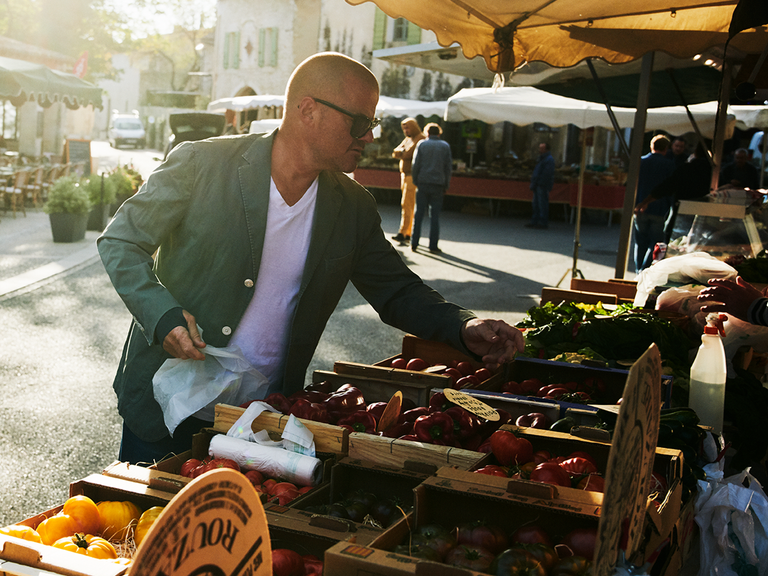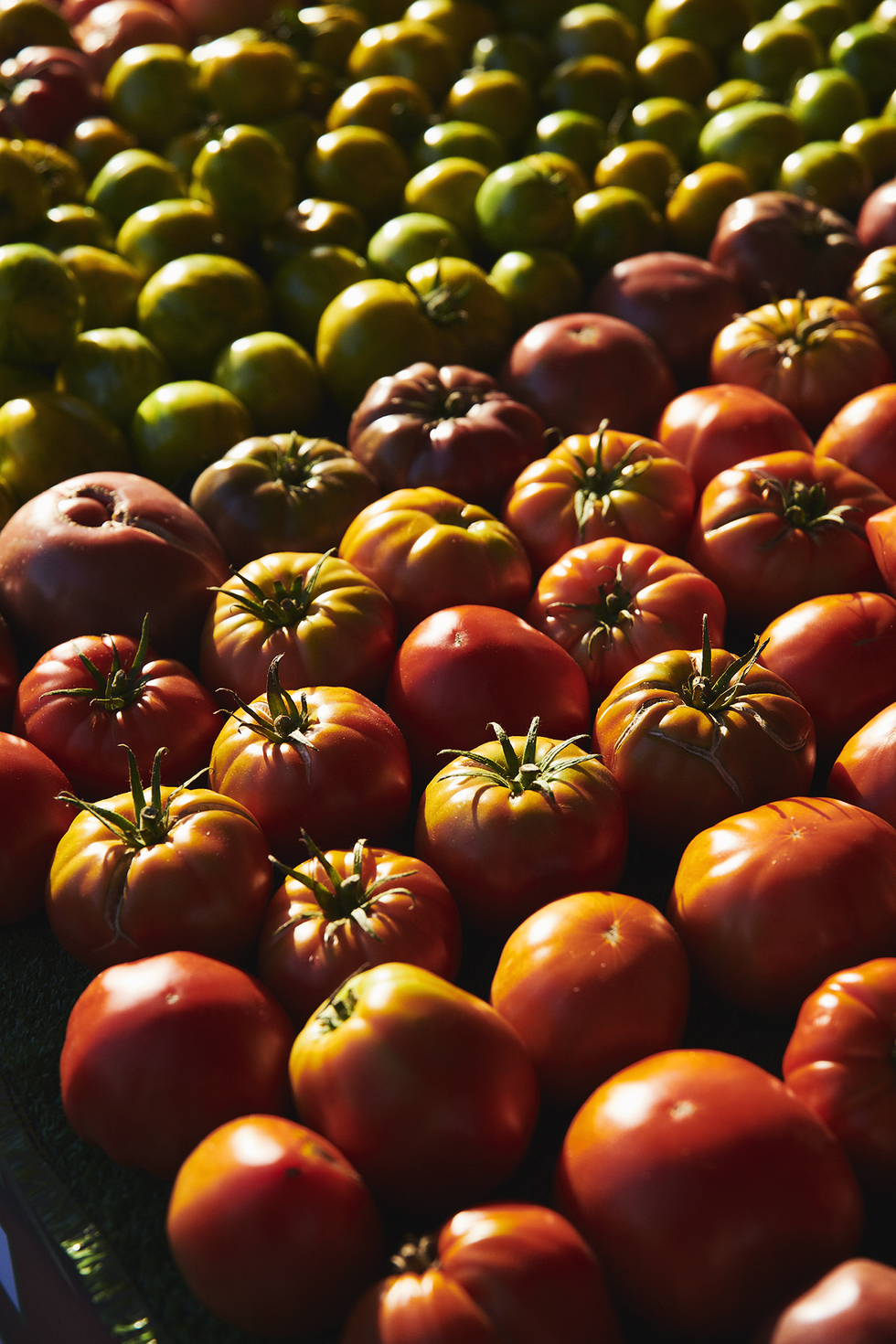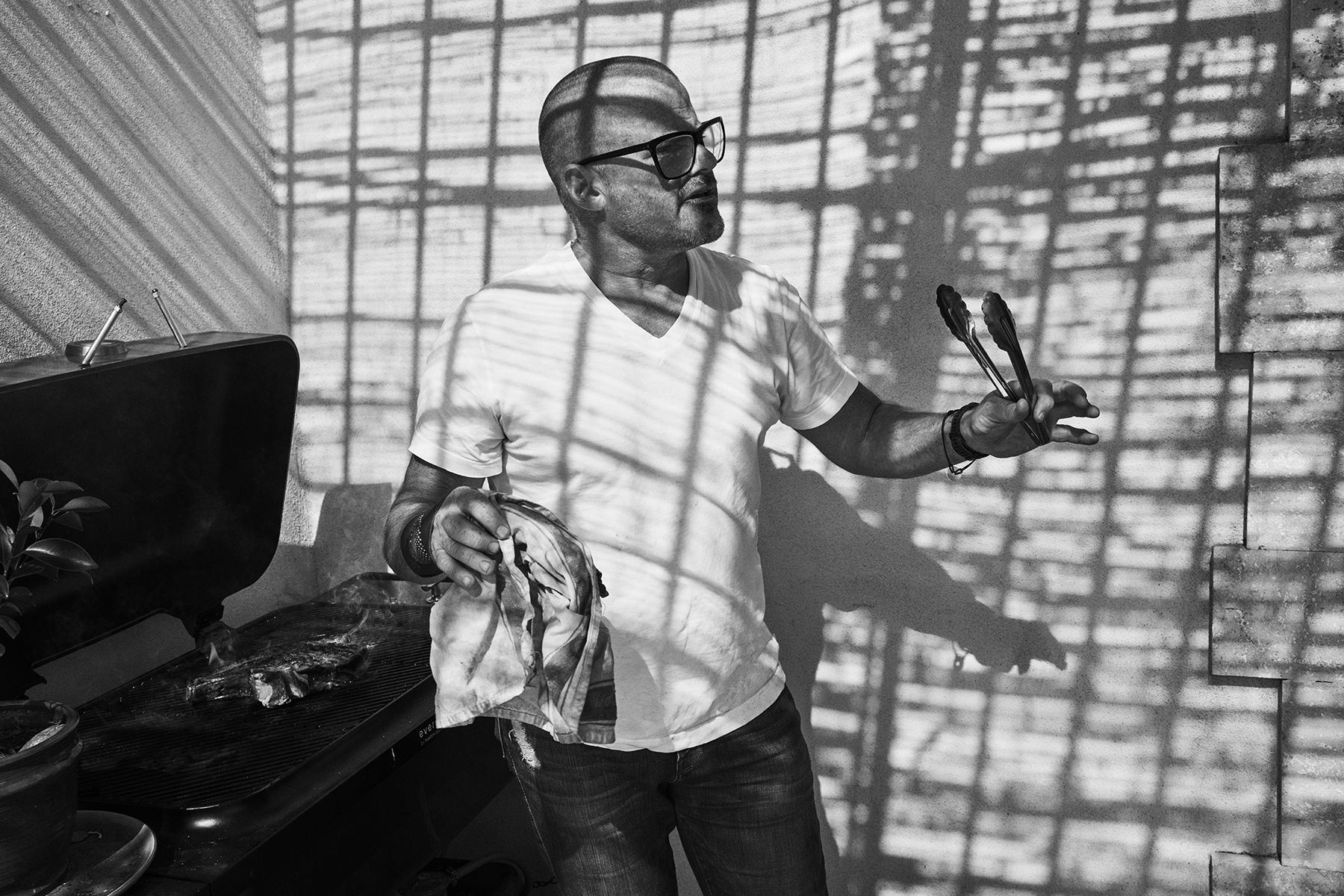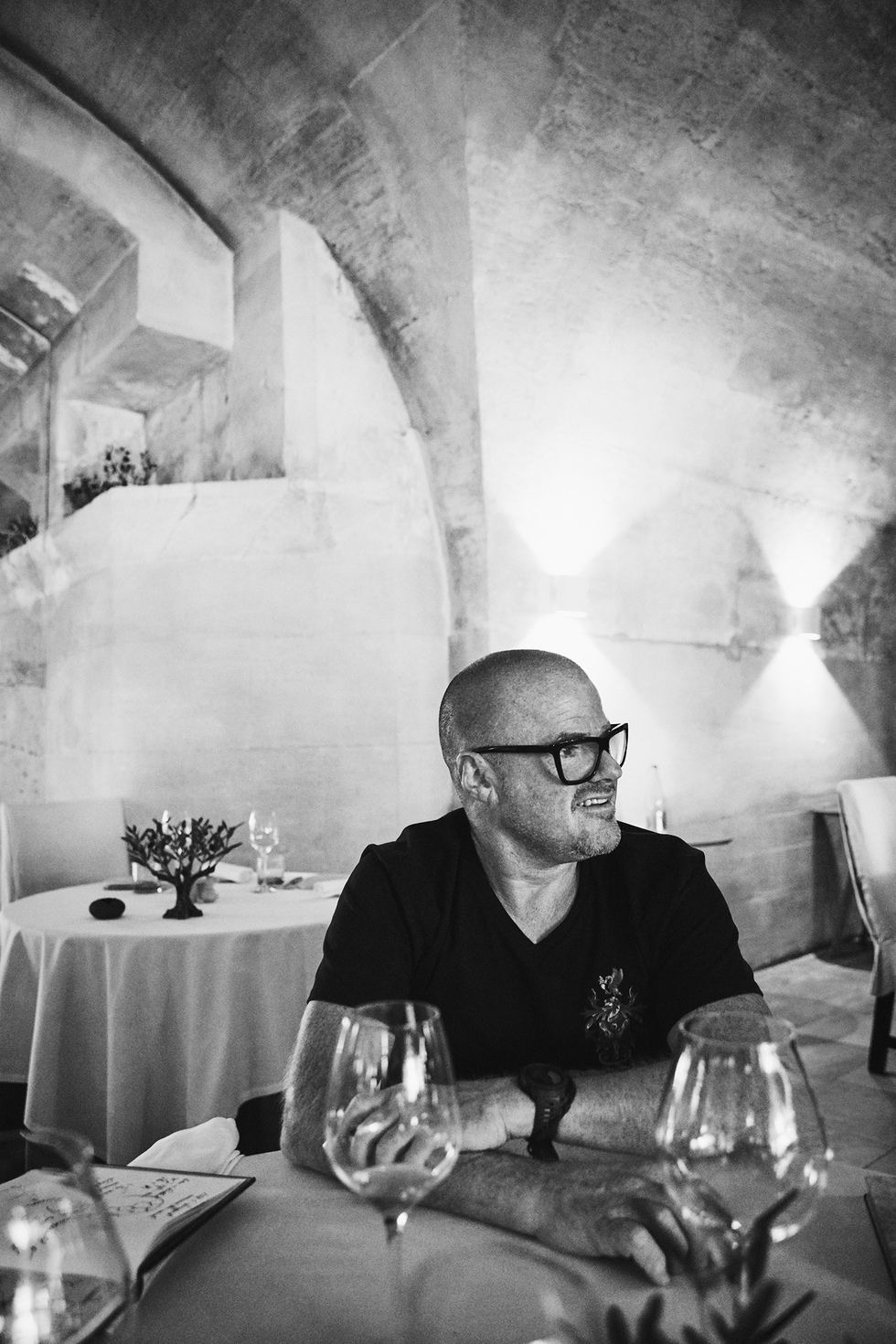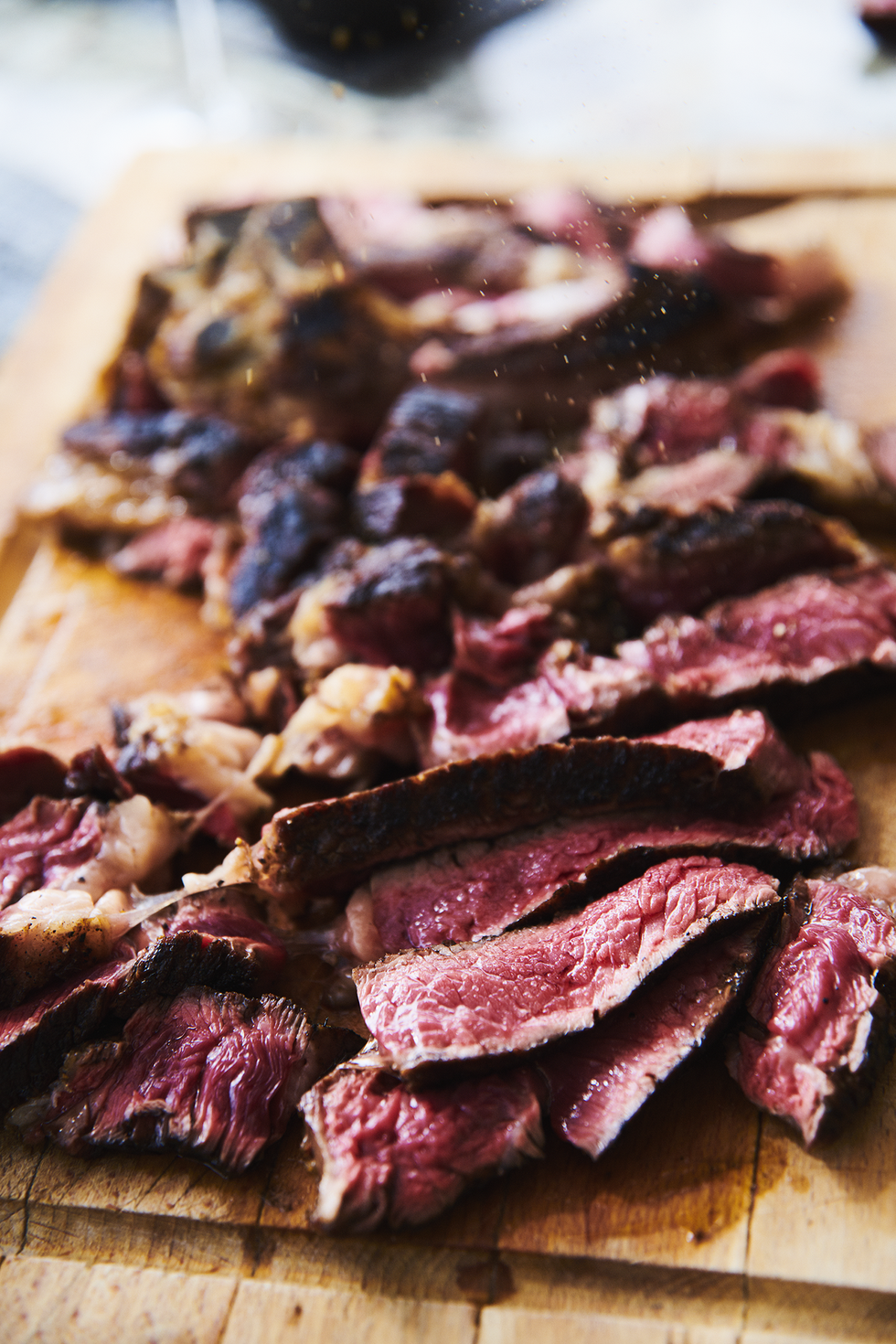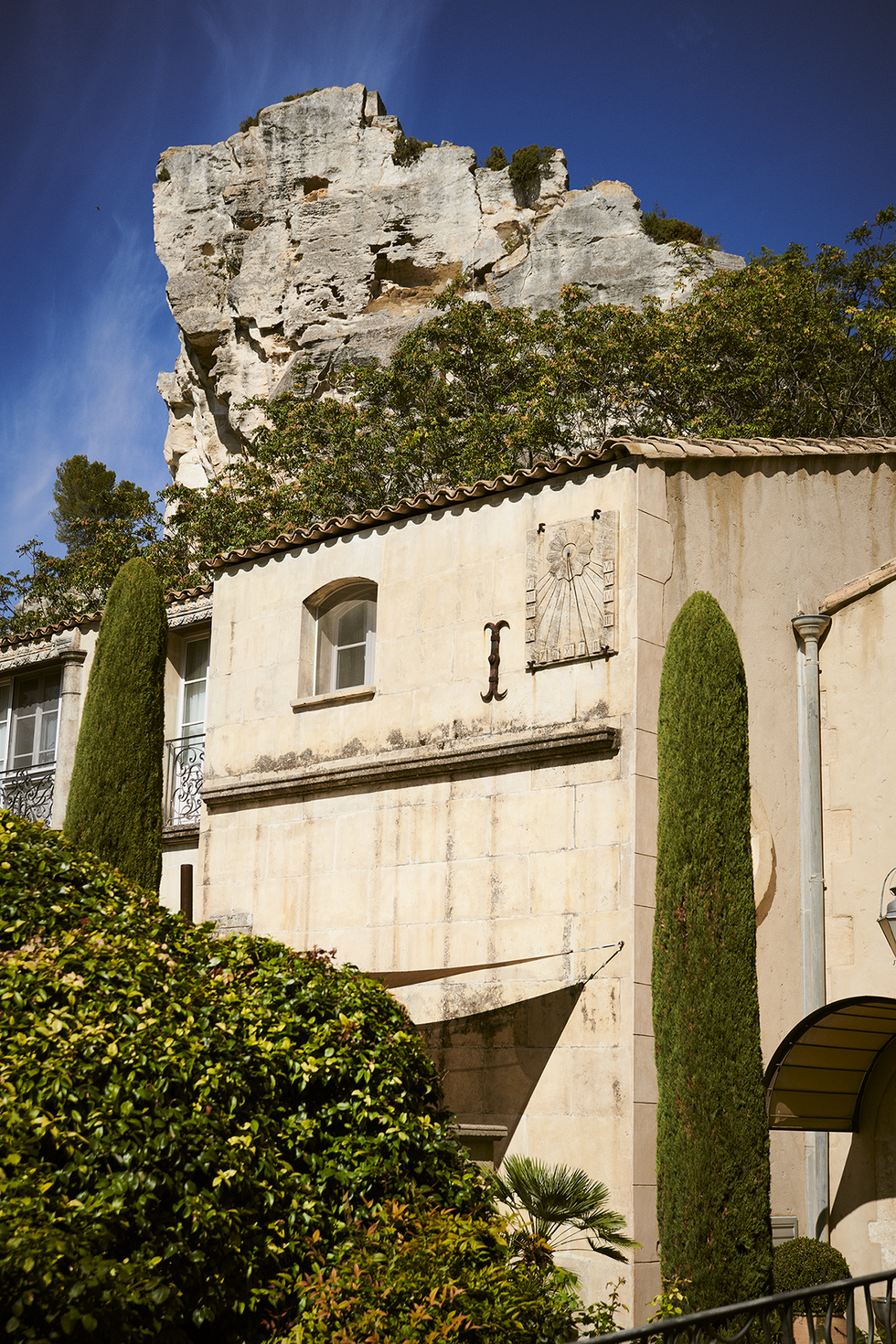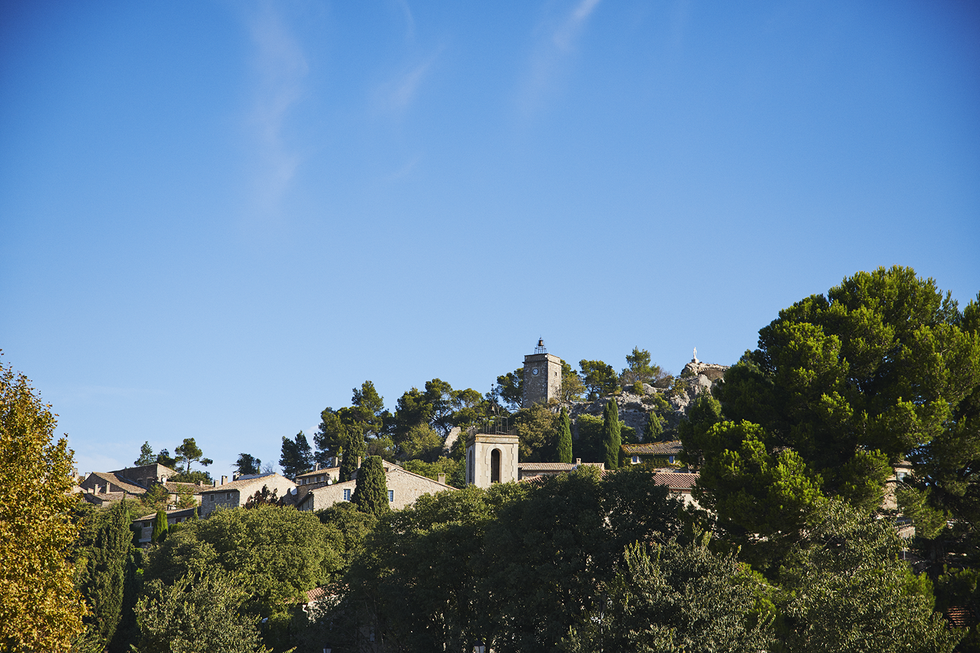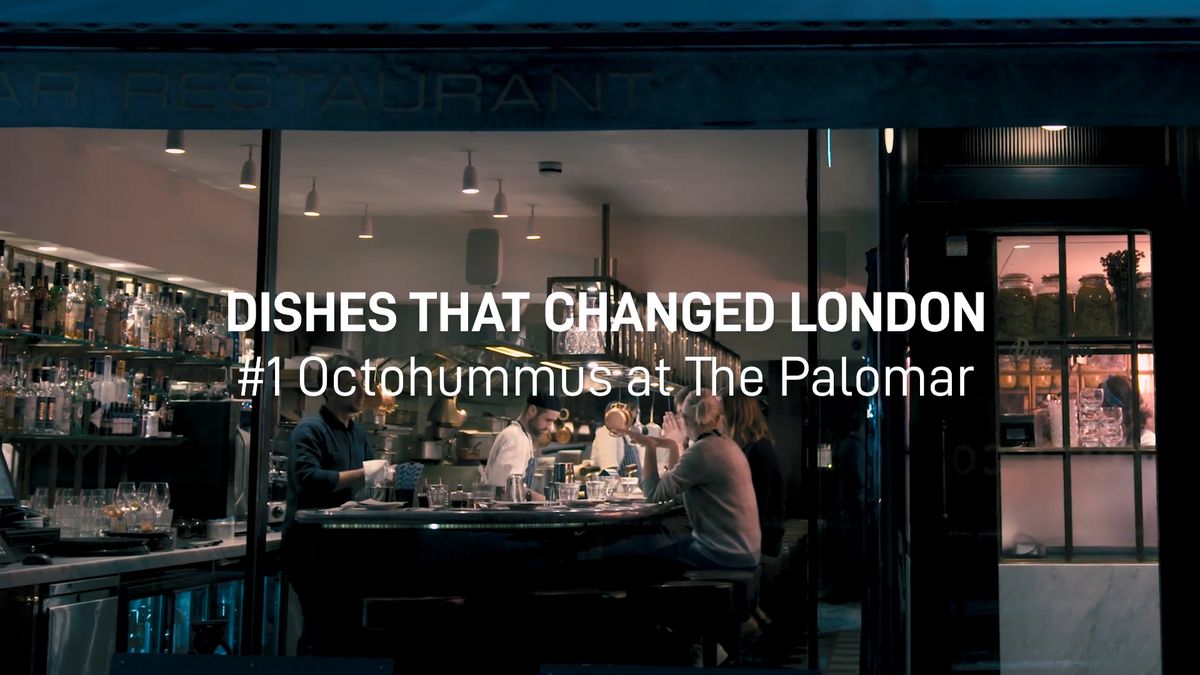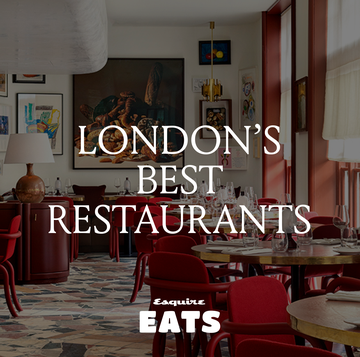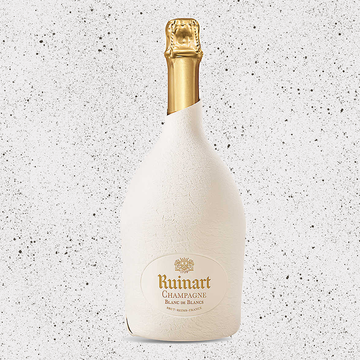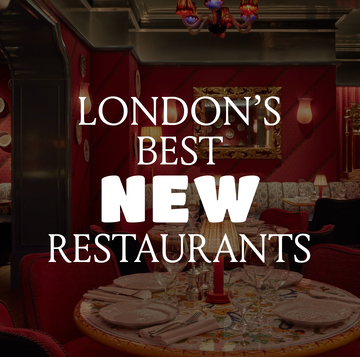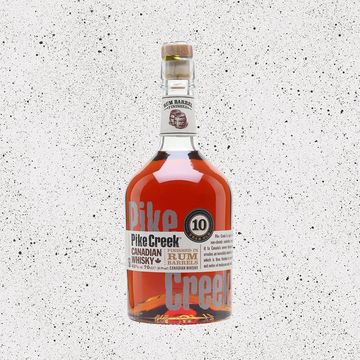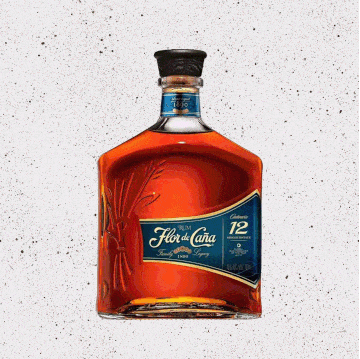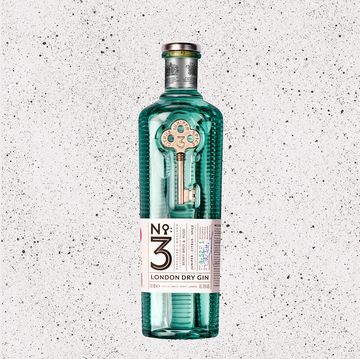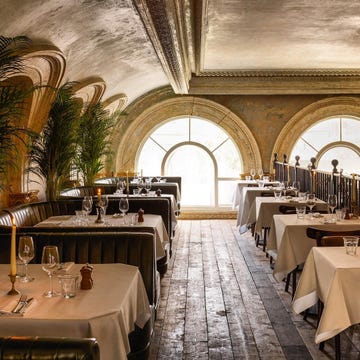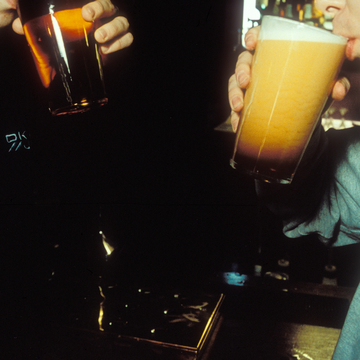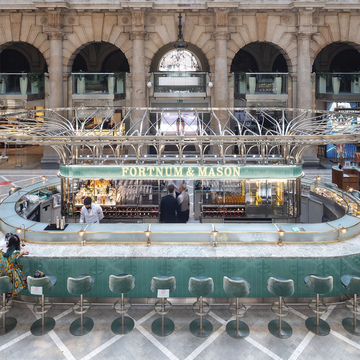1. LUNCH, BACKWARDS
The table had been booked for one o’clock, but two was fast approaching and we hadn’t yet taken our seats. A fierce wind hurried clouds across the sky and ushered leaves across the terrace of L’Oustau de Baumanière, in the town of Les Baux-de-Provence, in the south of France.
Heston Blumenthal had just started on his negroni, and sparked up a Marlboro, when a waiter approached and wondered if the famous chef would prefer to eat his lunch in reverse, as he had done once before at this restaurant: begin with petits fours, then pudding, followed by cheese, then main courses, starters, finally amuse bouche. The wine would go backwards, too: dessert, red, white.
It was a Thursday in early October. We were a party of four: Blumenthal, chef-proprietor of The Fat Duck, Britain’s most adventurous restaurant; James Winter, a former TV executive whose email signature describes him as head of creative strategy, Fat Duck Group; Simon Emmett, who took the photos on these pages; and me. Four Englishmen in early middle age, anticipating a convivial lunch in the name of research: Blumenthal, assisted by Winter, continuing his lifelong quest to understand the art and science of taste and flavour, and how those two, in harness with the other senses, can unlock memory, and release emotion; Emmett and me continuing our study of Blumenthal himself, which had begun that morning at his rented house, in the nearby village of Eygalières.
Blumenthal is a solid man of 53, burly, well fed, with a shaved head and spectacles in the shape of raised eyebrows — he has perhaps 60 pairs, made to his specifications by the London optician Tom Davies — giving him an appearance of impatient inquisitiveness. Blumenthal favours Nike trainers, jeans, and V-neck T-shirts, often with his own coat of arms printed on the chest, an assemblage of symbols that took him seven years to design and is, he told me, unexpectedly, his proudest achievement. It includes his motto: “Question everything.”
Blumenthal was immediately taken by the idea of the backwards lunch. “Great idea!” he said, waving his broken wrist at the waiter. (Some weeks previously he’d fallen off his electric mountain bike while cycling in the local mountains, Les Alpilles.) The notion had a whimsical, topsy-turvy, Lewis Carroll eccentricity to it, which is very Heston Blumenthal. Also, it offered a chance to experiment on the taste buds, to surprise them into action, offer them something unexpected, and confounding, and fun, all of which is quintessentially Blumenthalian.
Blumenthal’s character is fixed in the psyches of foodies, and in the consciousness of the wider public, even those who have never and wouldn’t necessarily want to eat in a Michelin-starred restaurant. He is the mad scientist of British cooking, his chef’s jacket doubling as a lab coat. It is an image that frustrates him — he finds it reductive — but also one that he must accept some considerable responsibility for creating. He is, if not mad, then certainly eccentric. And his scientific bona fides, while not formal, are substantial; he is the only chef to be an Honorary Fellow of the Royal Society of Chemistry.
Blumenthal made his name in the late Nineties and early Noughties experimenting with what became known as “food pairing” — identifying molecular similarities in different ingredients not previously used together, and combining them in a dish. He became associated with “molecular gastronomy”, a term he rejects (“boiling an egg is molecular gastronomy”, he told me), and famous as the creator of such provocations as snail porridge and crab ice cream. He developed many of his best-known dishes in a laboratory, rather than in a kitchen. He has repeatedly allowed himself to be photographed posing with test tubes and beakers, perhaps pouring liquid nitrogen onto frozen fruit, his glasses acting as goggles. His first TV series was called Kitchen Chemistry. So was his first book. You will struggle to find a profile of him that does not describe him as the Willy Wonka of the food world, as if Willy Wonka were not already the Willy Wonka of the food world.
The backwards lunch, then: could the kitchen do it at short notice, Blumenthal wanted to know? We didn’t want to make a fuss. Not at all, demurred the waiter. Blumenthal was disconcerted by the fact that we were already halfway through our aperitifs. Shouldn’t they come last, rather than first? But he accepted defeat on that point, and we headed inside to commence our feast.
For me, all this was new; I had never eaten at L’Oustau de Baumanière forwards, let alone in reverse. For Blumenthal, it was a homecoming, of sorts. It was at this restaurant, in the summer of 1982, that he first fell down a rabbit hole, as he puts it, into a world of multi-sensory wonder. He was 16, on holiday with his parents and his younger sister, none of whom had been to a Michelin-starred restaurant before. “I had never seen an oyster,” Blumenthal told me. They had lived — were still living, as most of us were, at that time — in a food culture that was, by today’s standards, unrecognisably unsophisticated. “Olive oil you had to buy from the chemist,” he said. “It was used for unblocking ears.”
Standing outside the Baumanière 37 years on from his first visit, I asked him if he could remember where the family had sat that day. He pointed to a table under a tree. He said I had to imagine it in the dark, with the trees lit up. “I can still remember the noise of the feet of the waiting staff crunching on soft gravel,” he said. “The sound of the crickets in summer is so loud, and the intoxicating smell of lavender everywhere, the chink of glasses. The sommelier had a leather apron and the cheese trolley was the size of a chariot. I’d never seen anything like this. Never.”
He was immediately struck by the idea that he should learn to cook. It was a decision that led, circuitously, to the opening, in 1995, of The Fat Duck, the tiny Berkshire restaurant that would, in 2004, receive its third Michelin star, and the following year top the annual list of The 50 Best Restaurants in the World.
He still remembers what he ate, in 1982. “I had a red mullet dish, with sauce vierge, which was tomatoes, olive oil, basil, little bit of pickled lemon. Then I had leg of lamb in pastry, with some green beans and gratin potatoes, and then I had the crêpes Baumanière, which are like souffléed pancakes.” But the quality of the food, and the skill of the cooking, while by no means incidental, is not the point. “When I was describing it over the years, I realised I was actually talking more about everything else. It was the effect of everything around me that made the experience amazing.
“We eat with our eyes and we eat with our noses and we eat with our hands and we eat with our emotions,” he said. “Sight, sound, smell, taste, memory, mood, awareness: all these affect our relationship with food, how we perceive taste and flavour.” This is his credo, these are the articles of his faith.
Returning to the Baumanière, Blumenthal experiences the Proustian rush that smell and taste — a madeleine dipped in tea, for example — can supply. “Your most important relationship is with yourself,” Blumenthal told me. Food, cooked and consumed “mindfully”, can bring you closer, or return you, to yourself.
Blumenthal’s sensibility is oxymoronic: he is a nostalgic futurologist, a chef-scientist determined to invent new and better ways of cooking food, and serving it, and eating it, in order to return to a specific, epiphanic moment in his own life, and to take his customers back to similar moments in theirs. To do that, he believes he needs to understand the science not only of cooking, but of feeling. Why, exactly, had he been so affected, as a teenager, by that meal at the Baumanière? Could he, by understanding that, take his cooking, and his restaurants, to a new level of excellence? More than that, a new level of significance?
In terms of skill and reputation, Blumenthal operates at the Olympian heights of fine dining, with the other demigods of food-ism, one of late capitalism’s secular religions: Ferran Adrià of El Bulli, René Redzepi of Noma, Thomas Keller of The French Laundry, and the eminences grises of French cuisine de haut en bas: Joël Robuchon, Alain Ducasse. He could have been forgiven for preparing, as 2020 looms, to make a lap of honour celebrating 25 years since the opening of his era-defining restaurant. Instead, he is plotting radical changes to the way he runs The Fat Duck. In 2014, he closed the restaurant for six months, temporarily relocating his team to Melbourne, Australia, where they worked on the launch of that city’s Dinner by Heston Blumenthal, sister to Blumenthal’s restaurant at the Mandarin Oriental in London. When The Fat Duck reopened it was with a new emphasis on “storytelling”, on personalisation — dishes created to the specific tastes and requirements, and even experiences, of individual diners.
I went for lunch in October and, after phone and email consultations with my allocated “Storyteller”, Salvatore, was presented, at the end of my meal, with a small corduroy pillow, the size of a cookbook, upon which sat two chocolate cigarettes, each containing strawberry sauce. Days earlier, at his prompting, I had described to Salvatore a memory of my own, of a formative moment in my life, in which I happened to be smoking a cigarette and drinking strawberry Ribena. My immediate response to the chocolate cigs was childlike delight — not something I feel too often, sad to say. Allied to that, a sort of giddy appreciation: this was a joke I was in on. It was the culmination of a lunch that had been a series of bedazzlements, a symphony of the strange and the arresting and the sensational, including a number of Blumenthal’s greatest hits: hot and cold tea; mock turtle soup; snail porridge. For all this magic, though, Blumenthal regards The Fat Duck as a work in progress. It’s nowhere near the place he wants it to be. “It’s too clumsy,” he told me.
He’d been thinking about the work of Punchdrunk, the British company who pioneered “immersive theatre,” breaking free of the sterility of the stalls and the circle and the proscenium, taking audiences into spaces outside the auditorium, interacting with theatregoers, making them part of the performance. Why should The Fat Duck not be the first “immersive restaurant”, liberated from the strictures of formal fine dining? Why should it be limited to a single location? Why should it have to involve tables and chairs and tablecloths and waiters and wine lists and all the other hidebound traditions of eating out?
What began to emerge, as we talked, was that Blumenthal’s journey of intellectual and emotional discovery had lately taken on a new aspect: it had broadened, and also intensified. He mentioned Joseph Campbell, the controversial American professor of literature, author of The Hero with a Thousand Faces, and proponent of the notion of the “monomyth” — the idea that all our foundational stories tell of a hero’s journey. Blumenthal used the most recent Mad Max film to illustrate the point. He also mentioned Homer’s Odyssey, and Woody, from Toy Story. The hero’s journey, pace Campbell, is often a journey home. This was Blumenthal’s journey, too. It was a return to the source. Blumenthal felt he needed to go back to the beginning, so that he could start again.
At the Baumanière, Blumenthal wanted to demonstrate to me the power of emotion to affect taste, just as taste can affect emotion. “Pick up your wine,” he said. I readied my glass. “The first sip,” he continued, “I want you to close your eyes and picture someone who fills you with love and happiness.” I pictured my kids, and took a swig. “Now picture someone who fills you with rage and dislike, anger, frustration, hatred.” I pictured Gordon Ramsay. (Just kidding, I pictured Paul Hollywood.) “It’s like a different wine,” said Blumenthal. It was true: the first sip was warm and smooth and rounded and full. The second: thin and sharp and bitter.
Despite the apparent success of his experiment, I must have looked sceptical. “I could look at you in your eyes and change the taste of that wine,” he said. It was a challenge.
“Go on, then.”
“The first time you look into my eyes,” he said, “it’ll be me looking at you. The second time I look at you, I’ll put myself back into my old fighting days. I’m imagining with my eyes open.”
It felt a bit unusual, staring into the eyes of a man I’d only just met. But Blumenthal’s is a benign presence, and I did it. Then I did it again, and he gave me a menacing glare. I enjoyed the second sip less.
There were more tests to come. He took out a pad and improvised two flashcards. On each he wrote the word “wine”: the first time in a curvaceous, bubble-font, the second time in a spiked, jagged script. After a few of these experiments it became harder to judge their efficacy; I blame the wine.
2. SOMETHING IN THE WATER
Is it the sunshine that bathes the Provençal countryside in soft light, buttering the farmhouses, caramelising the fields, sparkling on the streams? Is it the wind, the mysterious Mistral that spins across the landscape, twisting the trees? Is it the mountains, dramatic thrusts of limestone and bauxite, that dominate each horizon? Is it the soil, so fertile, in which the locals cultivate olives and figs and fruit, and grapes for wine, and goats for cheese? Is it the sky, so wide, and the air so clear? What is it, that caused Blumenthal to move with his young family, in the late summer of 2018, from their home in London to a tiny village in remote rural France?
It was morning in Eygalières, Blumenthal’s new home, a place with the unmistakable fragrance of recent investment. The village itself is not much more than a slender high street, sloping steeply upwards, past the church, towards a ruined tower. It is lined by cafés and restaurants of considerable appeal, plus an épicerie, a butcher, a chic bakery, a new wine shop. The buildings appear freshly painted, the streets are spotless. The view is a panorama of olive groves and vineyards, hills and valleys. This is the traditional French village as the animators at Pixar might computer-generate it.
Five minutes outside town, at the Blumenthal residence, he and I sat at a table on a terrace outside the kitchen. This was a rented house that he was then living in with his wife, Stephanie, their daughter, Shea-Rose, aged two, and Luna, nine, Stephanie’s daughter from a previous relationship. (Blumenthal has three grown-up children from his first marriage, to Zanna; they divorced in 2017, after 28 years.) The place was in some disorder because he and Stephanie and the girls were preparing to leave, after six months, for another, hopefully more permanent home, on the other side of the village. It would be their third house in the area in just over a year.
Blumenthal wasn’t able to give me a definitive answer to the question of why the family had moved here, probably because there isn’t one answer. We started with the water, the substance he was particularly focussed on at the moment. Eygalières, he said, was once called Aqualeria: “the land of water”. He told me about how, during a recent electrical storm, he had filled two bowls with tap water, left one outside and kept the other inside. In the morning he tasted them. The one that had been left outside tasted “thicker”.
“We know what to do with water,” he said. “We drink it, we wash with it, we cook with it. But we don’t know what it is. Depending on who you listen to, it’s got 30 to 70 unique properties. So glaciers shouldn’t float. It does the opposite of what other things do. And there’s a lot of research being done at the moment on water’s ability to carry data.”
What did he mean? “You can change the structure of it,” he said. “If there’s a big old river it’ll pick up data and information from people that have interacted with that river. And it has a memory and it can carry emotion.”
When Blumenthal gets his new lab up and running in Eygalières — his top priority — his experiments on water will begin in earnest. Blumenthal becomes impassioned when talking about his scientific projects, and his mind seems to go spinning off in multiple directions, producing a flood of information. Call it a stream of consciousness. His preoccupations, enthusiasms and obsessions — a bubbling stew of the philosophical, the esoteric, the scientific and the speculative — seem to multiply by the moment, and the connections between them were not always clear to me. He began to speak about a Japanese man I’d never heard of, called Emoto.
“He took water from different sources and subjected it to thought: gratitude, or love, or hate. Then he played it music, even showed it signs. Then he froze the water, to –23°C I think it was. And then you see the crystals.” He showed me images on his iPad. The water crystals that had apparently been played soothing music were uniformly beautiful and sparkling. The crystals that had been in some way abused were malformed, ugly, dull.
That night, back at my hotel, I Googled Emoto. The late Masaru Emoto was the author of a bestseller, The Hidden Messages in Water. He believed the molecular structure of water could be altered by human consciousness. He also conducted experiments on rice, including, according to Blumenthal, calling a bowl of the unsuspecting grain “a worthless piece of wotsit”. I think it’s fair to say his findings are disputed, though not by Blumenthal.
The question of what all this had to do with the family’s move to France, is one I was still grappling with. But it wasn’t just Emoto that Blumenthal wanted to talk about. In our first half an hour of conversation, while I drank coffee and made concentrating faces, he made reference to the work of the theoretical physicist Carlo Rovelli, an expert on time; a professor of bioengineering called Gerald Pollack who has talked about a fourth phase of water, after ice, vapour and liquid. He mentioned, not without embarrassment — “this is very rock ’n’ roll” — that in 2020 he is planning to go to the World Water Congress in Denmark.
He talked about Luc Montagnier, who won a Nobel Prize for helping to discover the HIV virus, and then took up the work of the late French immunologist, Jacques Benveniste, who once published an article in Nature magazine about what was then called “water memory”. “People thought he was mad,” said Blumenthal of Benveniste. “He died of cancer, because of the stress levels of the science world trying to rubbish him.”
He talked about an experiment involving the saliva of an astronaut, conducted by Cleve Backster, an interrogation specialist for the CIA and — this is true, I looked it up — former director of the Backster School of Lie Detection in San Diego, California. It was Backster, Blumenthal said, who experimented on plants with a polygraph machine and concluded that they feel pain.
“In the Seventies,” said Blumenthal, “sheep learned to roll over cattle grids around the world.” He didn’t mean that one flock circumnavigated the globe by rolling over cattle grids. He meant that in a near-simultaneous moment of inspiration, or unseen intercontinental extrasensory communication, or quantum something, multiple flocks of sheep around the world realised, if that’s the word, that they could cross cattle grids by rolling over them.
Plants in pain; water as a conductor for emotion; sheep in psychic sync; a man with the unimprovable Christian name “Cleve”. Increasingly, I felt myself to be setting out on a misadventure into the shadowy world of conspiracy theory and pseudoscience, in the manner of Jon Ronson, rather than a straightforward interview with a celebrity chef. This was just the beginning.
Blumenthal talked about a hospital in Sydney, Australia, where by bashing gongs, researchers had apparently found they could alter the shape of human blood cells. “If you believe in string theory,” he said, “every single thing on this planet is connected. Nothing is ever still.” He did not pause before continuing. “And for me, relativity doesn’t work in a black hole for two main reasons. One is there’s never been nothing. We talk about the universe expanding? I think it’s breathing.” The universe is breathing? “Like DNA,” he said. “I’m jumping around a bit,” he said, possibly noticing my eyes crossing.
Some days later, at Blumenthal’s direction, James Winter sent me an email with a Word document attached. It contained a scientific formula that aimed to explain the concept of “wisdom”. It had been written by Blumenthal’s “scientific advisor”, Bhusana Premanode, a “biological theoretical physicist” who apparently also goes by Pooh, as in Bear, and of whom he had spoken with great admiration, in Eygalières, describing him as “sort of my Buddhist monk”. It was Premanode — not, as I originally suspected, Freddie Mercury — who supplied the legend printed on the back of Blumenthal’s T-shirt: “Don’t stop me now”.
As Blumenthal talked on, the family’s new bulldog puppy, Harry adopted a splayed position beside my chair, as if he had lately fallen from the sky and crash-landed on to his stomach in this Provençal back garden, narrowly missing the assortment of Heston Blumenthal-branded barbecues. Indications that the dog had survived his ordeal came from a deep, rumbling snore that served as a background to his master’s rabbiting. Harry seemed unconcerned about string theory, quantum physics and the breath of the universe as, I couldn’t help noticing, did his mistress, a petite, stylishly dressed Parisienne in her early thirties, with a tumble of tawny hair and a highly attuned bullshit detector.
“You know,” she said to me in the local bakery the following day, as we bought coffee and excellent croissants, “It’s not easy being married to a crazy man.” She meant it fondly. But she definitely meant it.
Blumenthal has ADHD. “I know I have a busy head but I don’t know how busy it is compared to everyone else’s,” he said. “But it’s very sensitive to temperature.” How so? “I can tell the temperature of a room to within a degree, roughly.” What was the temperature right now? “In here? 20. Between 19.5 and 20.5. Because my head starts to perspire, consistently, over a certain temperature.” This has been going on since he was a boy. “I know the temperature of most of the airlines,” he said, meaning the cabin temperature of passenger aircraft. “British Airways is 21. Qantas, 22. Singapore, 23 to 24 depending. Emirates is 25°C.” (I have not checked these, preferring to take Blumenthal at his head’s word.)
He returned to the subject at hand — water, and how to restructure it — by referring to the Schumann resonances: “The sun hits the planet, you’ve got the magnetic field around the Earth, it deflects it otherwise we’d be dead, but what comes through, because we’re spinning at 24,000kmh, are these frequencies that run round the Earth, like a Tesla coil. Those seven main frequencies match up to the seven main chakras, various vital organs in the body. So, by applying certain sound treatment, resonance, to humans, you can make a very big difference to their health.” He drew me a diagram.
My head was spinning by now. Perhaps not at 24,000kmh, but not far off. He was talking about Tibetan singing bowls, the pH value of different emotions, the difference between a “human being” and a “human doing.”
“So I’m here because I married a Frenchwoman,” he concluded.
This line of reasoning I could grasp more readily. No diagram necessary. But he was immediately contradicted by his wife, who had rejoined us with a cup of coffee and a smoke.
“No!” said Stephanie, puffing out her cheeks. “People think he’s here because I’m French, but no. I was so happy after five years in London! He decided to come and live here and I said yes. But it’s not because of me.”
Blumenthal assented. “It wasn’t her choice to come here.”
And he began to talk about the peculiar quality of the light, in this part of France, and the sharp contrast here between the light and the shadows, and why that resonates with him, particularly, because he believes that in order to live well, and fully, one must embrace the darkness as much as the light, and consider the invisible as much as the visible.
“I’ll come back to water later,” he promised.
3. THE FAR QUENELLE
On our last day in Eygalières, Blumenthal cooked lunch. We met him early, at the market, where stalls sold truffles and lavender-scented soap and tomatoes. In the butcher’s, Blumenthal hunted down a hunk of steak, and from various stalls he gathered vegetables for ratatouille.
Back at the house, Stephanie and I spent a good while plugging in and then unplugging different extension leads and trying to force cables to stretch farther than they wanted to, but we couldn’t get Blumenthal’s charcoal-burning barbecue to start. Probably the fuse had gone, suggested James Winter. There was another, bigger, charcoal-burning grill, but that, too, was malfunctioning. The more traditional grill had a broken lid, but it would do.
When the grill had reached optimum temperature, Blumenthal put the steak on. He turned it every 30 seconds or so, while Simon Emmett took photos of the flames. He was making a point: the accepted thinking on cooking meat is that you first brown each side. “It doesn’t work,” he said.
Blumenthal is self-taught. As a teenager he trained himself, in his parents’ kitchen in High Wycombe, working to recipes from the classic French cookbooks, which he translated using a French-English dictionary. He had no idea, at that time, of opening a restaurant. He was just fascinated by food, as he was by savate, a French form of full-contact kick-boxing, which he practised with the same obsessiveness he brought to cooking. Later, he switched to table-tennis. Now it’s the mysteries of the cosmos.
In 1984, when he was 18, Blumenthal came across a newspaper review of a book by Harold McGee, On Food and Cooking: the Science and Lore of the Kitchen. He bought the book. “I’d failed my chemistry O level,” he said. “A lot of it was too complicated for me. But there was a comment in there that browning meat doesn’t keep in the juices. Which flies in the face of what everyone says.”
If browning meat kept in the juices, as advertised, it would be impossible to have a well-done steak. “What sizzles is water,” he said. “The more you cook a steak, the more the proteins contract, like scrambled eggs, and they squeeze the water out.” Browning can be very important for flavour, Blumenthal said. It gives a crust to the meat. But it doesn’t keep the juices in.
“I thought, ‘Bloody hell, if that’s true, how many other things I’ve read aren’t true?’” It was then, he said, that he developed his “question everything” approach.
His first experiments were with ice cream. “I wanted to know, since I had 20 French chefs’ cookbooks that all had vanilla ice cream recipes in them, how come none of them was the same? Do they know why they’re putting these ingredients in, or is it just what they’d been told?”
He questioned everything: Why sugar? Why cream? Or milk, or skimmed milk, or eggs? Why cook the custard to the temperature you’re told to cook it to? What happens if you keep going past that?
“I wasn’t overly keen on the eggyness of ice cream,” he said. “I wanted to try and get rid of it. Egg yolks coagulate at 82°, roughly. I wondered, ‘What happens if you cook the egg yolks to 69°, so the custard is not thicker, but then hold it for longer for pasteurisation, and end up with a much cleaner ice cream flavour?’” No, too thin. “Then, ‘What happens if you do exactly the opposite, intentionally fuck up the ice cream? Let’s scramble it, and then pass it through a sieve.’ It was thick, and it was just egg yolk. And it reminded me of having my cooked breakfasts at home, a Saturday treat. That’s when I thought, ‘Let’s try it with bacon.’ That’s how bacon and egg ice cream came about.”
He wasn’t trying to invent that particular dish. “It was about the journey, the process of discovery, the curiosity. And that turned out to be my drive.”
Around that same time — the mid-Eighties — Blumenthal wrote to the top 20 restaurants in the British Good Food Guide, seeking work. He received two replies. “One was a ‘No’, one was from Raymond at the Manoir.” Raymond Blanc was then and remains today one of the most respected chefs in the country. His Le Manoir aux Quat’Saisons, in Oxfordshire, is still a place of pilgrimage for gastronauts.
On Blumenthal’s first morning, he was given a “skyscraper” of green beans to chop. “Some French guy walked past and said something to me so I threatened to smack him,” he remembered. “Probably not a common thing for a young commis to do. I heard this voice saying, ‘What are you doing over there? Come over here.’ It was Marco [Pierre White, the future enfant terrible of English cooking]. He was on the meat section. We became friends.”
Blanc offered Blumenthal a permanent job. He turned it down, preferring to follow his own path, rather than serve an apprenticeship chopping beans. (It says something for both of them that he and Blanc remain friends.) Instead of an apprenticeship in a professional kitchen, Blumenthal found whatever work he could that would allow him to spend his evenings experimenting at home. “It turned out to be the harder option, I think,” he told me. He became a photocopier salesman. (“Horrible.”) A repo man. Then he did a bookkeeping course and went to work for his dad, keeping the ledger at the family office equipment hire firm. He did that for six or eight years. “I didn’t find it interesting,” was his summary of that period.
The Fat Duck might have been called The Far Quenelle. That was Blumenthal’s father’s suggestion for a name for his son’s restaurant. (Say it out loud.) It was a rundown pub in the sleepy riverside village of Bray when Blumenthal found it. “It was dodgy,” he remembered. “The first week, someone pulled a knife on someone else in the garden.” In order to raise the £180,000 necessary to buy it, he sold the cottage he’d bought in High Wycombe and moved in with his parents, bringing with him a pregnant Zanna and their two-year-old son. Together, they were taking a leap in the dark.
Blumenthal borrowed a further £70,000 for the refurbishment, including £10,000 from his father. The chairs cost £50 from a local ironmonger. The oven was secondhand; it had a gas burner, with domestic pressure rather than professional so that even boiling a pot of water was a chore. “I gave up everything and stuck myself in a concrete box,” he summarised. “It was chaos.”
For close to a decade from 1995, he existed on 15 hours’ sleep a week. It sounds improbable, but Blumenthal can explain in detail how he left home each morning at 5am and often didn’t return until 1am, when he would start on paperwork. “It was a level of exhaustion I never knew existed,” he said. One day he was so tired he tried to light a blow torch with tap water. Hot tap water, he reassured me: he hadn’t completely lost it. For eight years he didn’t miss a single service. Not without shame, he told me that a colleague of his used to tell an anecdote in which he sent her an email at 2am and another at 5.30am, saying, ‘I haven’t heard from you: did you get my email?’”
The Fat Duck began as an unpretentious country bistro. “Five starters, five main courses, four desserts,” Blumenthal said. “I think dessert was £2.75. Only one main course broke the £10 mark: steak and chips, £10.50. It was me and a pot washer. Literally. And two people front of house.” If there was any clue to the future it would have been the chips, which were triple-cooked to a new recipe, developed by the young chef-patron himself, after much experimentation in his parents’ kitchen.
The restrictions imposed by the size of the restaurant and its basic equipment were formative. “Having this poky, useless kitchen, that really shaped me,” he said. It was green beans, again, that caused a turning point. With his underpowered hob, he could only boil a few at a time. “It made me question: do you need salt in the water?” The review he had read of the Harold McGee book was by Nicholas Kurti, a Hungarian physicist whose hobby was cooking. Kurti was an advocate of applying scientific knowledge to culinary problems. In a sense he was the godfather of molecular gastronomy.
Blumenthal tried to contact Kurti, in 1998, but learned he had recently died. Kurti’s widow supplied him with a list of names of sympathetic scientists and Blumenthal began to phone them, one after the other, asking the same question: do you need salt in the water to cook green beans? At length he reached Peter Barham, a physicist in Bristol. “He said to me, ‘Eureka! A chef who is interested!’” They began to collaborate.
This was the early days of molecular gastronomy. Blumenthal’s test kitchen, at The Fat Duck, was at the forefront of this movement, along with El Bulli, in Roses, Catalonia. Those restaurants “changed the shape of food, changed the shape of cooking,” Blumenthal said. But there was a downside: “People started thinking it was about pipettes and tweezers and syringes and clipboards.”
At the house in Eygalières, he sliced the steak roughly into uneven strips, one of which he handed to me. It was nubby and fatty and tender and juicy, and wholly delicious. I said so.
“I know I can do that, I know I can cook,” he said to me. This was a statement of fact, plain and simple. It didn’t come across as boastful. But as he made it, he seemed emotional. I felt that perhaps he was frustrated by trying to communicate all his many other more complicated ideas. This idea, this thing — a steak, cooked to perfection by a man who knew, perhaps better than anyone on the planet, what he was doing — was easy to get across. And it was warmly received.
4. STARRY, STARRY NIGHT
Whatever else we did during our time in Provence, Blumenthal and James Winter were determined Emmett and I should see the asylum where Vincent van Gogh was a patient for a year, from May 1889, and made some of his most famous paintings. Apart from the fact that van Gogh was, as Blumenthal is, enchanted by the light and colours and landscape of this part of France, it wasn’t immediately clear to me why they were so adamant about this trip.
The asylum was — and still is, though they don’t use the word asylum now — housed in a former monastery, just outside the nearest substantial town, Saint-Rémy-de-Provence, about 20 minutes, by car, from Blumenthal’s house. There’s a visitor centre there now. It costs €6 to get in. Cheap, when you consider the price of entry for van Gogh was his left ear.
And so we set off, four of us folded into a compact German hire car, all limited leg room and remarks on the beauty of the countryside, and segues into half-remembered French history. Once we were on the road, Blumenthal handed me a portable speaker, and instructed me to play “Starry, Starry Night”, meaning the Don McLean song, “Vincent”. As Winter steered us down tight, twisty roads, I fiddled with the Bluetooth settings on my phone, trying to connect first to the speaker, and then to access my Spotify account. Reception was patchy, and for a moment I worried it might not be possible, but Blumenthal was determined I should keep trying.
Meanwhile, as the cypress trees whistled past, and Winter negotiated oncoming agricultural vehicles, Blumenthal talked us through his developing tastes in music. Reference was made to shopping for seven-inches at Woolworths, ELO’s “Mr Blue Sky”, Marshall Jefferson’s deathless Chicago house classic “Move Your Body” and nights at Soho’s much missed Wag Club.
At length, I found a live version of the song — best I could manage under the circumstances — and it began to play. Blumenthal took the speaker back and turned up the volume. “Starry, starry night,” sang McLean, mournfully, as we approached the outskirts of Saint-Rémy, “Paint your palette blue and grey.” For an unusual moment, Blumenthal was silent, listening. “Look out on a summer’s day / With eyes that know the darkness in my soul.”
Blumenthal twisted towards me, raised his spectacles and pointed at his left eye. It was filled with tears. “See?” he said, and he gritted his teeth.
We arrived at Saint-Paul de Mausole, the asylum, where Winter squeezed the car into a space next to a family of Spanish tourists. Blumenthal and I marched inside. (“Chefs’ day out?” said an English punter to me, recognising my recognisable companion. “Something like that,” I said.)
In a cloister by a walled garden, I asked him what it was about the song — and about van Gogh — that so moved him. What did he identify with? “I think it’s the frustration that most people feel,” he said. “I’m careful not to say I feel like I’m misunderstood.”
I asked if, in fact, he felt like he was misunderstood? “Yes,” he said. “You get pigeonholed. This is not what people have actually said but that idea of, ‘Stick to what you’re good at: chopping onions.’” He was frustrated, he said, because he was trying to explain ideas he strongly believed in, to an unreceptive audience. Sometimes he thought he should stop talking, he said, “because they’re never going to understand you. And the more you talk to them, the more the likelihood of them resisting even more.”
Why would people resist his ideas? “Because you might intimidate them. They might not understand, they might not be interested. So many reasons. But that feeling of not being understood, in some respects it’s pushed me even harder. But I’m feeling that the stuff I started to do 20 years ago or 15 years ago or 10 years ago is actually starting to get through. Like [the idea of] looking into the senses. Before, it was: ‘You’re just the snail porridge guy.’”
I thought of the McLean song: “They would not listen, they did not know how / Perhaps they’ll listen now.”
Vincent van Gogh was a tortured genius who committed suicide, at the age of 37, by shooting himself in the chest, after years of periodic insanity and poverty. (Although Blumenthal has a theory about van Gogh’s death; he suspects foul play.) Blumenthal is a superchef, richly rewarded. At the time of writing, he is in possession of both ears. The connection is not an easy one to make.
“In the last year of being here, and reflecting,” Blumenthal said, “I’ve realised how lonely I was, a few years ago.
“I didn’t cry from when I was a kid until I was at least 45,” he said. “Never shed a tear. Blocked. Now I can cry. It’s a fantastic thing to be able to have.”
At the Baumanière, I’d asked if Blumenthal missed England. “Do I see myself spending the rest of my life here?” he said. “Probably not, but I don’t know. I certainly am here for a good few years.”
I wondered if some kind of crisis had precipitated his move. He allowed that it had, without going into specifics. “I don’t know how to say it without sounding cheesy,” he said. “But this is a bit of a new chapter. And part of that is cleaning up the old chapter. Putting stuff in place to be able to do all the things I want to do. I think I had to go through a period that I’m still going through,” he said, meaning — I think — a period of struggle and
uncertainty. “It’s a stabilising process,” he said. “I haven’t fully
settled in yet.”
He said there had been too many distractions in England for him to be able to do the work he wanted to do. “But much of it was about me not having the discipline to ignore the distractions.” Some of his frustrations were with his work. It’s no news that running a restaurant, especially an exceptionally high-end restaurant — or a number of them, in his case — is a fraught venture. Blumenthal’s various enterprises employ close to 700 staff across about 20 separate companies. He listed his commercial interests with an air of acceptance, rather than achievement. “There’s Dinner in London, Dinner in Australia, there’s the Perfectionist’s Café [at Heathrow Airport]. There’s a book department. There’s Waitrose [the supermarket for which he produces an expansive range of products]. There’s Salter [thermometers]. There’s the TV stuff. And Everdure [barbecues].”
“It’s not my business,” Blumenthal explained. “I sold it to my uncle years ago, so I could get on with what I’m telling you about now. It’s run by his company. It’s very complicated.
“I don’t want to be a hamster on a wheel,” he said. “The more money I bring into the company the more it goes to pay the people that are needed to bring more money in. There’s just not enough hours in the day.”
James Winter recalled a visit to the Guggenheim Museum, in New York, at which they stood in front of Impressionist paintings of this region of France. He turned to Blumenthal: “You were like, ‘This is where I need to be. In that landscape, with no telephone’.”
At the van Gogh asylum, we came to “Vincent’s room”, which Winter suggested was not really Vincent’s room, but a simulacrum. Refusing to be discouraged, Blumenthal wondered if Emmett would like to take his picture sitting on Vincent’s bed. Or “Vincent’s bed”. Emmett looked unsure, but Blumenthal took up position. I was instructed to kneel on the floor, out of shot, holding back Vincent’s curtain, or “Vincent’s curtain”, so that the light fell on Blumenthal, who adopted a suitably sombre pose.
In the gift shop, Blumenthal picked up some laminated “Starry, Starry Night” place mats. He waved them at me across the shop. “For lunch,” he said. “Cool,” I said. Then he spotted a painting of Karl Lagerfeld for sale. It was largish, and reddish, and I wasn’t sure why it was here in the van Gogh asylum gift shop. Nevertheless, he bought it for Stephanie, who is, he said, a devotee of the late Chanel designer. We walked back to the car, Blumenthal carrying the painting in his good hand. I carried the place mats.
5. THE BEST CHEF IN THE WORLD
One morning, Blumenthal, Stephanie and I sat outside a café in Eygalières, drinking coffee. Stephanie had been talking about her life as Mrs Blumenthal. I asked him if he thought he was a difficult man to live with? “The feeling of always playing a supporting role, that’s difficult,” he said, putting himself in Stephanie’s shoes. “If the roles were reversed and she was famous, how would I feel?”
How would he feel? “Terrible!” he said. “I don’t think I’d have the strength. I think she handles it much better than I would.”
Stephanie ran a hand through her hair and said she saw herself as her husband’s protector. “Heston is very nice,” she said. “He doesn’t see the bad in people.” Blumenthal nodded. “I’m a people-pleaser,” he said. “Every child develops a defence mechanism. Mine was fighting, kick-boxing. But my physical strength, I think, was in inverse proportion to my mental strength.”
As for his many schemes, scientific and otherwise, Stephanie was typically firm. “With Heston,” she said, “sometimes I say, ‘Non. It’s a lot of bullshit’. I try my best to keep Heston…” She searched for the word. Grounded? I suggested. “Yes, very important. He has his job, to be a chef, and all his restaurants, and the other part, I think it’s a problem for Heston, he wants to mix everything, it’s very difficult. I always say to Heston: ‘Your job is to be a chef, the best chef in the world.’”
I repeated this, or a version of it, to her husband later that day, as he was outlining the difficulties of getting his lab set up in Eygalières, and convincing people that his experiments would bear fruit. I wondered if he didn’t miss the relative simplicity of turning up at a kitchen each morning and cooking for a living? Although running a traditional restaurant was exhausting, this adventure he was on, this desire to push at the limits of science, this need to reinvent not just his own restaurant, but the very idea of a place to serve and consume food, it all sounded so complicated. And,
after all, he was so very good at the cooking.
But he was adamant. “A chef is only part of who I am,” he said. “It’s not all I am.
“I’m me,” he concluded. “Just like everyone is.”
